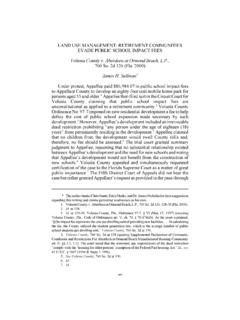Transcription of A SHORT OVERVIEW OF DEVELOPMENT IMPACT FEES
1 City Attorneys Department league of california cities Continuing Education Seminar February 27, 2003 Peter N. Brown, City Attorney Graham Lyons, Deputy City Attorney City of Carpinteria A SHORT OVERVIEW OF DEVELOPMENT IMPACT FEES SB 322494 v4 2A SHORT OVERVIEW OF DEVELOPMENT IMPACT FEES BY: PETER N. BROWN, CITY ATTORNEY, CITY OF CARPINTERIA GRAHAM LYONS, DEPUTY CITY ATTORNEY, CITY OF CARPINTERIA CITY ATTORNEYS DEPARTMENT league OF california cities 2003 CONTINUING EDUCATION PROGRAM FEBRUARY 27, 2003 I.
2 DEFINITION OF DEVELOPMENT IMPACT FEE A DEVELOPMENT IMPACT fee is a monetary exaction other than a tax or special assessment that is charged by a local governmental agency to an applicant in connection with ap-proval of a DEVELOPMENT project for the purpose of defraying all or a portion of the cost of public facilities related to the DEVELOPMENT project. (Gov. Code 66000(b).) The legal requirements for enactment of DEVELOPMENT IMPACT fee program are set forth in Govern-ment Code 66000-66025 (the "Mitigation Fee Act"), the bulk of which were adopted as 1987 s AB 1600 and thus are commonly referred to as AB 1600 requirements.
3 A DEVELOPMENT IMPACT fee is not a tax or special assessment; by its definition, a fee is vol-untary and must be reasonably related to the cost of the service provided by the local agency. If a DEVELOPMENT IMPACT fee does not relate to the IMPACT created by develop-ment or exceeds the reasonable cost of providing the public service, then the fee may be declared a special tax and must then be subject to a two-thirds voter approval. (Cal. Const., Art.)
4 XIII A, 4.) Practice Pointer: Both the political and legal implications of having a DEVELOPMENT IMPACT fee de-clared to be a special tax can be exceedingly grim. The best defense against such an outcome is careful construction of the DEVELOPMENT IMPACT fee program and scrupulous attention to substan-tive and procedural requirements of the Mitigation Fee Act. The City Attorney must play an active role in this process. II. PUBLIC AGENCY S AUTHORITY TO IMPOSE DEVELOPMENT IM-PACT FEES The power to exact DEVELOPMENT IMPACT fees arises from the city s police power to pro-tect the public health, safety and welfare.
5 (Cal. Const., Art. XI, 7.) The police power allows a city to act in the interest of its citizenry and to enact and enforce ordinances and regulations that are not in conflict with state law. Charter cities have the additional power to regulate by virtue of their plenary authority with respect to municipal affairs. (Cal. Const., Art. XI, 5.) SB 322494 v4 3A. A TRUNCATED HISTORY OF cities ' AUTHORITY TO EXACT DEVELOPMENT IM-PACT FEES. While the california Mitigation Fee Act was enacted in 1987, local governmental agen-cies had been collecting IMPACT fees for many years.
6 IMPACT fees, originally called exactions, were first adopted in the 1920s by cities seeking new infrastructure financing alternatives. (Practical Issues in Adopting Local IMPACT Fees, Jerry Kolo and Todd J. Dicker, excerpt from State and Local Government Review, Vol. 25, no. 3 (Fall 1993); 197-206). In 1949, california courts first adopted the reasonable relationship test be-tween a project's conditions of approval and DEVELOPMENT impacts. (See Ayers v.)
7 City of Los Angeles, 207 1 (1949).) This original pronouncement of the test required that an exaction by a local agency be reasonably related to the DEVELOPMENT project's IMPACT on the need for public infrastructure. The concept of exactions expanded in the 1960s with the enactment of the Quimby Act, which authorized either the dedication of land or pay-ment of in-lieu fees for DEVELOPMENT of parks. (Gov. Code 66477; see also Guide to california Planning, 2nd Ed., William Fulton, p.
8 181.) In the 1970s, california courts and the california Attorney General affirmed cities abil-ity to exact from new DEVELOPMENT both the dedication of land and the payment of funds. In Associated Homebuilders, Inc. v. City of Walnut Creek, the california Supreme Court upheld the imposition of DEVELOPMENT IMPACT fees to mitigate indirect impacts created by new DEVELOPMENT . (4 633 (1971).) In 1976, the california Attorney General is-sued an opinion affirming a city's authority to impose an exaction provided it furthers implementation of the city s general plan and bears at least an indirect relationship to the impacts created by the proposed DEVELOPMENT .
9 (59 129 (1976).) The modern law of exactions was established beginning in the late 1980s. 1. Nollan v. california Coastal Commission and the Enactment of the Mitigation Fee Act. In 1987, the Supreme Court decided Nollan v. california Coastal Commission, 483 825 (1987). As most every land use lawyer now knows, the Nollans proposed con-struction of a two-story home within the same footprint as their existing one-story beachfront house. As a condition of issuing a coastal DEVELOPMENT permit, the Coastal Commission required that the Nollans grant a public access easement across the beach in front of their house.
10 The Nollans successfully argued, and the U. S. Supreme Court held, that the exaction (the grant of public easement) was not related to the IMPACT created by the DEVELOPMENT (increased building height). Proof of such an "essential nexus" was re-quired if exaction was to be lawful. The Supreme Court, however, did not specify how close the nexus must be. With the passage of Proposition 13 in 1978 and the decline in local government revenues, local government increasingly relied on IMPACT fees in order to mitigate the impacts cre-ated by new DEVELOPMENT .






